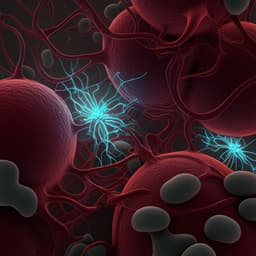
Physics
Ultra-short pulse laser acceleration of protons to 80 MeV from cryogenic hydrogen jets tailored to near-critical density
M. Rehwald, S. Assenbaum, et al.
Discover how cutting-edge research by Martin Rehwald, Stefan Assenbaum, and their team is revolutionizing particle acceleration using laser plasma technology. Their work shows that a micrometer-sized hydrogen jet plasma can achieve remarkable proton energies of up to 80 MeV, overcoming traditional limitations and enhancing radiation doses at high energies.
~3 min • Beginner • English
Introduction
The study addresses how to achieve higher-energy, controllable laser-driven proton beams using practical, high-repetition-rate targets. High-power petawatt lasers at >10^21 W/cm^2 enable advanced ion acceleration mechanisms that depend critically on target plasma density relative to the (relativistic) critical density. While mechanisms such as TNSA, RPA, relativistic transparency–assisted regimes, collisionless shocks, and magnetic vortex acceleration are predicted to outperform TNSA under near-critical conditions, their experimental realization is limited by insufficient control over target density profiles and temporal evolution. The research investigates whether a self-replenishing cryogenic hydrogen microjet, hydrodynamically pre-expanded by a controlled prepulse, can reproducibly tailor the density from overdense to near-critical/underdense to optimize acceleration. The purpose is to identify and exploit the optimal density regime and mechanism to maximize proton energy and beam quality with a single, debris-free target concept, relevant for applications requiring compact, high-dose-rate ion sources.
Literature Review
Prior work has explored various target configurations and density tailoring strategies to access advanced ion acceleration regimes: overdense foils and targets pre-expanded by heater pulses; engineered near-critical targets via nano-structured composites (foams) and low-density materials like solid hydrogen; and underdense gas jets. Acceleration mechanisms considered include TNSA, HB-/LS-RPA, relativistic transparency–assisted hybrid regimes, synchronized acceleration at relativistic critical density (RTF-RPA), CSA, and MVA. Experiments have shown transparency-enhanced hybrid regimes producing >90 MeV protons with high-energy laser systems, but routine control over plasma density profiles and unambiguous mechanism identification has remained challenging due to target geometry constraints and diagnostic limitations requiring ultrafast X-ray probing for opaque solids. Cryogenic hydrogen jets have shown efficient proton acceleration and support high repetition-rate operation, suggesting they are promising platforms for density tailoring and mechanism studies.
Methodology
Experimental platform: The DRACO PW Ti:Sapphire laser delivered linearly polarized, ~30 fs pulses with ~18 J on target at 800 nm, focused to ~2.6–3 µm (FWHM), reaching a normalized vector potential a0 ~ 50 (petawatt-class intensity). A recollimating single plasma mirror improved temporal contrast to keep the target unperturbed until ~2 ps before peak.
Target: A continuous, debris-free, cylindrical cryogenic hydrogen jet of 5 µm diameter (solid hydrogen) was formed by injecting liquid hydrogen (~18 K) through a 5 µm aperture into vacuum; evaporative cooling solidified the jet. Fully ionized, the electron density is ~5.1×10^21 cm^−3 (~30 nc at 800 nm). The jet velocity (~100 m/s) provided self-replenishing high-repetition-rate operation; a mechanical chopper protected the nozzle.
Pre-expansion control: A low-intensity prepulse (generated via a pick-off mirror before final focusing) was temporally delayed by 10–170 ps relative to the main pulse. The prepulse had 55 fs duration (due to substrate GDD), focused with the same optic to 32 µm × 19 µm (FWHM), with peak intensity ~5.8×10^17 W/cm^2, inducing isotropic hydrodynamic expansion to tailor the core density and surface gradients. The main pulse then interacted with the tailored profile.
Diagnostics: On-shot, high-resolution optical shadowgraphy probed the target with a synchronized off-harmonic 515 nm beam (resolution ~1.5 µm) to determine the shadow diameter d as a proxy for expansion state; in dedicated expansion studies a second probe at 1030 nm (resolution ~4 µm) provided two-color imaging to map density evolution to transparency thresholds. Two Thomson parabola spectrometers (TPS) at 0° and 45° measured proton spectra; occasional RCF stacks recorded beam profiles and cross-calibrated yields. A glass-ceramic screen 450 mm downstream monitored transmitted/bypassing 800 nm laser light; subtraction of the bypass fraction (estimated from probe images) yielded a measure of transmission through the jet.
Hydrodynamic modeling and ray tracing: A 1D radially symmetric FLASH hydrodynamic simulation modeled expansion from an initial homogeneous plasma column (radius 2.5 µm, 30 nc) with varying initial temperature. Ray-traced synthetic shadowgrams (ZEMAX) established the relation between simulated radial density profiles and observed shadow diameters for 515/1030 nm. Best agreement with measured two-color expansion dynamics was obtained for an initial plasma temperature of ~150 eV. This framework enabled inference of the on-shot density profile from measured d in full-energy shots.
PIC simulations: 3D PIConGPU (v0.4.3) simulations modeled laser–plasma interaction across 16 expansion states (shadow diameters 6.2–33.5 µm) using radial density profiles from the hydrodynamic model. The laser was linearly polarized (x), propagating along +y, λ=0.8 µm, with a0≈33 (slightly reduced from experiment to reflect alignment/shot-to-shot variations), 30 fs Gaussian temporal FWHM plus an exponential rising edge fitted to measured contrast (intensity ~5.55×10^−5 of peak at −600 fs to 0.1894 at peak; energy conserved by subtracting ramp energy from peak). Spatial resolution: 24 cells per wavelength in all axes; Δt≈0.064 fs; absorbing boundaries; Yee field solver, Esirkepov deposition, Boris pusher. Box: 28.8 µm (x) × 14.4 µm (z); target center 14.4 µm from entrance boundary; +43.2 µm rear space; run time 240 fs after pulse peak at target center. Ionized hydrogen modeled with 3–18 macroparticles/cell depending on target size. Transmitted laser energy was quantified by integrating EM energy for y>20 µm at +120 fs (subtracting light that would pass around underdense regions). Relativistic transparency and critical fronts were tracked via density thresholds.
Shot selection/overlap metric: Due to limited precision of independent laser focus and jet position measurements, central hits were coarsely identified by selecting the lowest third of ceramic screen signals (reduced residual light) within subsets of similar d, indicating better laser–target overlap. This mitigated, but did not eliminate, overlap-induced scatter in Emax.
Key Findings
- Proof-of-concept demonstration of high-energy proton acceleration (up to 80 MeV) from a cryogenic hydrogen microjet using ultra-short PW-class pulses.
- Controlled hydrodynamic pre-expansion (via a 55 fs, ~5.8×10^17 W/cm^2 prepulse, 10–170 ps ahead) tailored the target density from solid (~30 nc) toward near-critical/underdense, enabling a density scan with on-shot validation by shadowgraphy.
- Experimental proton spectra (TPS at 0°) showed optimal performance near shadow diameter d≈11 µm, reaching Emax≈80 MeV; unexpanded jets (d≈5 µm) yielded ~38–40 MeV; larger expansions (e.g., d≈28 µm) reduced Emax and yield.
- Over >30 shots, many exceeded the best unexpanded Emax, confirming reproducible enhancement with pre-expansion; at d>22 µm, Emax remained >20 MeV.
- Emission pattern evolved from near-isotropic in the horizontal plane (0°/45° Emax ratio ≈1 at d=5 µm) toward forward-directed with increasing d; transmitted light fraction increased with d, evidencing growing transparency.
- Two-color expansion study and 1D hydrodynamic modeling (with initial T≈150 eV) reproduced measured shadow-diameter evolution and provided quantitative density profiles for PIC input. Best-performing experimental shots correspond to profiles with peak density reduced from 30 nc to ~21 nc while retaining steep gradients.
- 3D PIC simulations predicted significantly higher Emax (>100 MeV) for intermediate expansions (d~20 µm) where on-axis density drops below the relativistic transparency threshold γ nc (γ=1+a0^2/2). For larger d, transmitted energy rises and Emax falls; for smallest d, Emax~40 MeV (TNSA-dominated). Simulated trends agree with experiment, including forward-emission shift and transparency increase; quantitative agreement is near-perfect at the overdense and underdense extremes.
- Mechanism identification across regimes:
• Overdense (small d): TNSA dominant with some HB-RPA contribution at the front; isotropic emission in xy-plane.
• Optimal near-critical (intermediate d): Enhanced acceleration at the relativistic transparency front (RTF-RPA), where the moving relativistic critical surface reflects the laser inside the bulk and sustains strong accelerating Ey fields that co-move subluminally, enabling prolonged proton acceleration.
• Underdense (large d): Magnetic vortex acceleration (MVA) at the rear side dominates; channeling and strong toroidal Bz fields (tens of kT) drive confined accelerating fields along laser propagation.
- Noted strong shot-to-shot variability in PIC near the optimal region due to sensitivity of laser propagation/heating to initial fluctuations; experimental Emax scatter predominantly attributed to laser–target overlap and limited TPS acceptance.
- Simulations suggest that with more homogeneous density profiles and steeper gradients, energies >100 MeV are achievable at current facilities for optimized RTF-RPA or MVA scenarios.
Discussion
The results demonstrate that precise control of the target density profile in a single-species cryogenic hydrogen jet enables access to advanced acceleration regimes beyond TNSA, directly addressing the challenge of realizing near-critical density acceleration at high repetition rates. The observed twofold increase in proton energy (to 80 MeV) with pre-expansion, the shift of emission toward the forward direction, and increased transparency collectively indicate a transition from overdense TNSA to a relativistic-transparency–assisted regime. Hydrodynamic modeling constrained by two-color shadowgraphy allowed start-to-end PIC simulations that reproduced the overdense and underdense limits and captured the optimal near-critical behavior. The identification of RTF-mediated acceleration in the optimal regime provides a mechanistic basis for designing targets that synchronize accelerating fields with ions for sustained energy gain. The findings are significant for compact, high-dose-rate proton sources in applications such as warm dense matter research and medical physics, showing a path to 100 MeV-class, high-repetition-rate operation using existing PW lasers and debris-free targets. Remaining discrepancies between simulated and measured optimal conditions are attributed to overlap sensitivity, model assumptions in pre-expansion, and intrinsic instability of the near-critical propagation/acceleration process.
Conclusion
This work demonstrates 80 MeV-class proton acceleration from a debris-free, self-replenishing cryogenic hydrogen microjet by tailoring the density profile via a controlled prepulse and exploiting advanced acceleration in the near-critical regime. On-shot optical probing and hydrodynamic modeling provided quantitative density profiles, enabling realistic 3D PIC simulations that identify a transition from TNSA to enhanced acceleration at the relativistic transparency front, and to MVA in the underdense limit. The approach validates a practical route toward 100 MeV-class, high-repetition-rate proton accelerators with existing PW laser technology. Future work should: (i) further optimize density homogeneity and gradient steepness to maximize RTF-RPA or MVA; (ii) improve laser–target overlap robustness (e.g., wider sheet-like jets) to reduce shot-to-shot variability; (iii) refine pre-expansion models to include non-thermal electron populations; and (iv) explore parameter scans of pulse shape and polarization to stabilize near-critical propagation and enhance energy gain.
Limitations
- Shot-to-shot variability in maximum proton energy was dominated by limited laser–target spatial overlap; TPS acceptance further constrained measured Emax and angular distributions.
- The transmitted light measurement underestimates transmission for strongly expanded targets due to diffraction beyond the screen.
- Central-hit selection was empirical (lowest-third of ceramic screen signals within d bins); residual overlap-related scatter remains.
- Hydrodynamic pre-expansion modeling assumed an initial thermal electron distribution; non-thermal contributions could shift the optimal d and introduce offsets between simulated and measured trends.
- Near-critical PIC simulations showed intrinsic sensitivity/instability to initial fluctuations (independent of PIC resolution/particle number), leading to variations in predicted Emax in the optimal region.
- The target density profile in experiments was not fully optimized for homogeneity and gradient steepness; simulations indicate further gains (>100 MeV) are feasible with improved profiles.
- Use of a plasma mirror for contrast cleaning, while effective, can limit practical repetition rate; single-shot 80 MeV performance without the mirror was achieved but with uncontrollable pre-plasma conditions.
Related Publications
Explore these studies to deepen your understanding of the subject.







